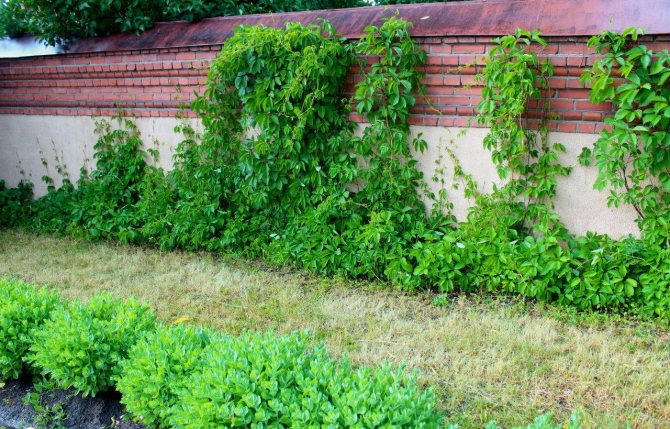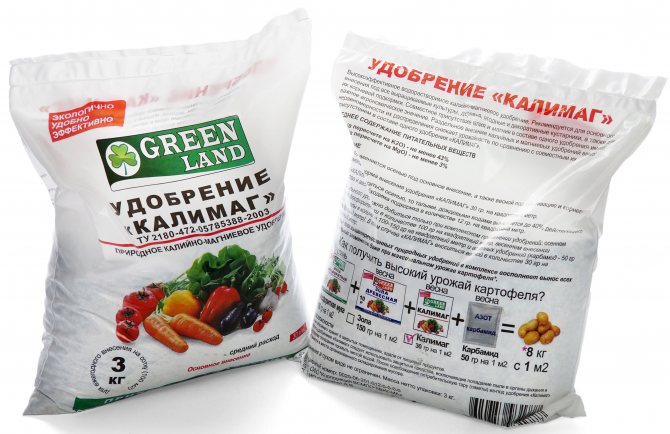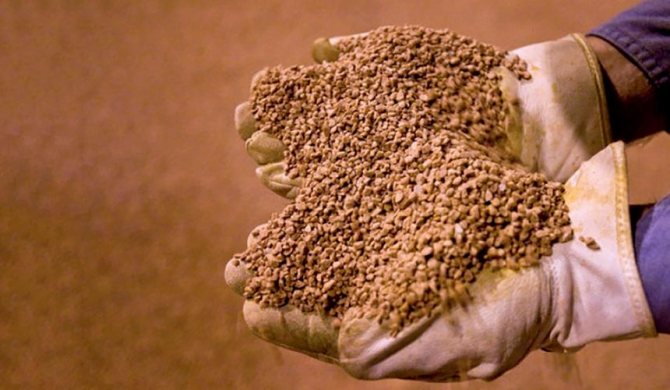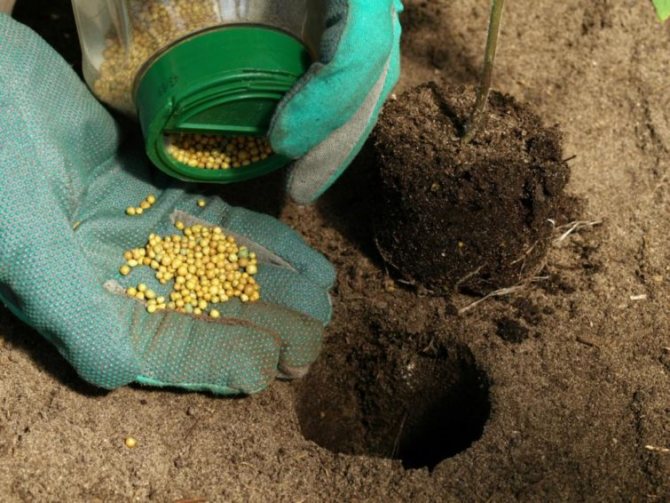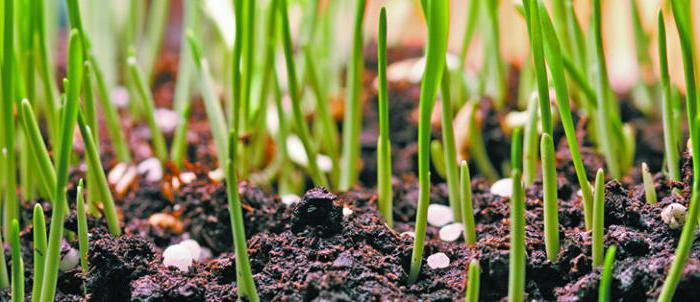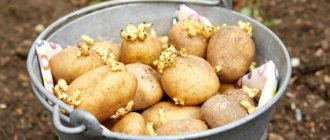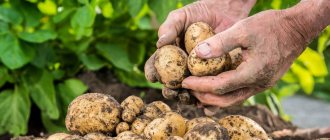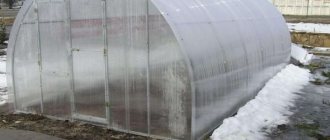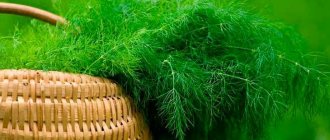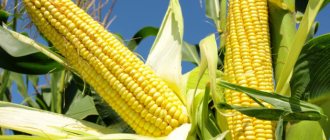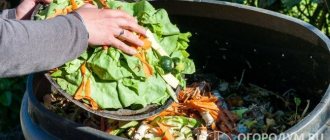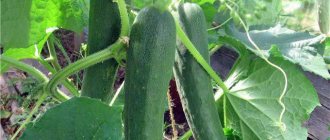- Raw potassium salts
- Concentrated potash fertilizers Potassium chloride
- Potassium nitrate
- Cucumbers
The main characteristic of mineral potash fertilizers is good solubility in water, potassium is not able to accumulate in the soil. It retains better on heavy soils (loam, clayey), in light soils it is less, the most depleted in potassium are peaty.The value of potassium for vegetable and fruit crops: ■■ increases the frost resistance of crops; ■■ increases plant immunity, enhances resistance to fungal infections; ■■ helps to increase overall yields; ■■ improves fruit taste, appearance and shelf life. Signs of potassium deficiency in plants: As a rule, potassium deficiency does not appear immediately, but towards the middle of summer: ■■ Plants become faded and stunted; ■■ shoots become thin; ■■ the leaves turn yellow, then turn brown, die off along with the petioles; ■■ the leaves become wrinkled, curl into a tube; ■■ Sometimes plants bloom unnaturally and then form small fruits.
Concentrated potash fertilizers
These are potassium chloride and sulfate, potassium-magnesium concentrate, potassium-magnesium sulfate (chenite).
Potassium chloride
Potassium chloride ranks first in this group in terms of popularity due to the largest specific gravity of potassium oxide (K2O) - 52–63%. However, as the name implies, it contains an admixture of chlorine, which is extremely toxic to many plants. Externally, it is crystals of white color with a gray tint, possibly pink, which dissolve well in water. Potassium chloride must be added in advance: fruit and berry crops do not tolerate chlorine. Recommended for application before winter, for deep digging.
Potassium sulfate, or potassium sulfate
Potassium sulfate, or potassium sulfate, does not contain chlorine. It can be applied to the soil both in autumn and spring, used both in open and closed ground and mixed with other mineral fertilizers. Represents small white crystals with a yellowish tint. Does not cake. Most often used on cruciferous crops that respond well to sulfur applications.
Benefits of additives and classification
Even novice gardeners and gardeners know about the benefits of fertilizers. Without their use, it is impossible to grow garden crops. Fertilizers are mineral or organic substances that are added to the soil to improve its properties and increase yields. Due to the presence of one or more components, mixtures help crops to grow and develop correctly, to increase "productivity" and enhance their qualities.
There are several ways to classify fertilizers, but most often they use the division into mineral and organic. Each of them has its own advantages and disadvantages, however, mineral dressings are most often used.
However, despite the obvious superiority, not everyone uses organic complexes. The fact is that organic fertilizers are peat, manure, bird droppings, humate, humus, compost, green manure, straw and other similar elements. Not everyone is ready to tinker with them. Therefore, if the soil does not require urgent assistance, it is fed with mineral fertilizers.
Complex mineral fertilizers
Double (nitrogen-potassium and phosphorus-potassium) and triple (nitrogen-phosphorus-potassium) fertilizers are produced.
Potassium nitrate
Potassium nitrate - it contains K2O (44–46%) and nitrogen (13%). Outwardly, these are small gray-white crystals with a yellow tint, soluble in water. It can be used even after the formation of ovaries, since a small amount of nitrogen will strengthen the culture, but will not spur the active growth of the vegetative mass.
Potassium nitrate most often used for feeding root crops (carrots and beets) and berry crops, suitable for tomatoes. Fertilizer can be applied in dry and liquid form. The last feeding is carried out at least 3-4 weeks before harvesting.
Kalimagnesia
Kalimagnesia - complex potassium-magnesium fertilizer, chlorine-free, hygroscopic, non-caking. It is used as a top dressing (10 g / m2) with a low content of mobile magnesium in the soil. Used for feeding potatoes.
Nitrophoska
Equal amounts contain nitrogen, potassium and phosphorus oxides. Can be used for any garden culture.
Nitroammofoska
The content of nitrogen, phosphorus and potassium is approximately equal. It is used for the main application (randomly or locally) and pre-sowing application, as well as for foliar feeding.
Nitroammofoska
We have listed almost all major potash fertilizers. Their names are well known to agricultural technicians, which cannot be said about novice amateur gardeners. First, we discussed what are the options for mono-feeding (pure potassium). However, it is best for plants when they immediately receive a complex of essential minerals. Therefore, pay attention to nitrogen-phosphorus-potassium fertilizer. Experiencing a deficiency in at least one of these substances, the plant will not bear fruit well. Therefore, every gardener must have it in his arsenal. This complex fertilizer contains 17% nitrogen, 24% phosphorus and 28% potassium. Its use is extremely useful for all types of horticultural crops. Nitrogen-phosphorus-potassium fertilizer has a particularly good effect on tomatoes.
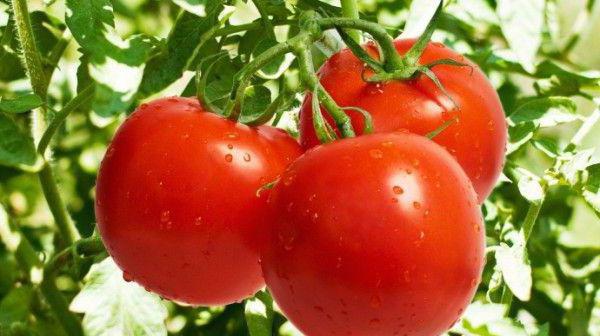
They are less sick with scab, root and stem rot, late blight. They are fed no more often than twice during the whole season. Another big fan of this fertilizer is grapes. This southern inhabitant tolerates the winter quite tolerably in central Russia, if he regularly receives such top dressing. This fertilizer is used with great success on almost any soil. However, it showed itself best of all on black earth and alumina.
Natural source of potassium - wood ash
As mentioned above, potassium is needed in a garden plot in small quantities, therefore, it is almost never applied in its pure form. An excellent source of potassium is ordinary wood ash, in addition, it contains phosphorus, calcium and other trace elements. The percentage of potassium in ash depends on the type of wood being burned and ranges from 7 to 40%, for example, the ash of young deciduous plants contains up to 14% potassium oxide, in conifers it is less. The presence of potassium oxide in the ash allows it to be used on soils with high acidity.
Ash is stored in a dry place, as moisture promotes leaching of potassium from it.
Behavior in soil
Kalimagnesia, like all potash fertilizers, weakly migrates along the soil profile, the exception to this rule is sandy and sandy loam soils.
As a double salt of potassium sulfate and magnesium, it decomposes into potassium ions K, magnesium and sulfate - ions (SO42-).
Suliate ion (SO42-) is a mineral form of sulfur that is readily absorbed by plants.


and is easily absorbed by the root system of plants, like all sulfur-containing
The potassium ion (K) weakly migrates along the soil profile, as a very active ion it is absorbed by the AUC by the type of exchange and non-exchange absorption.
Exchange absorption is reversible and constitutes an insignificant part of the total absorption capacity. As a result, the mobility of potassium in the soil profile is limited and its availability to plants increases.
Potassium absorbed by the non-exchangeable (fixed) type is less mobile than exchange-absorbed and practically unavailable to plants. Such absorption is characteristic of clay minerals with a three-layer swelling lattice (minerals of the hydromica and montmorillonite groups)
In the presence of these minerals in the soil, potassium cations penetrate into the inter-package spaces in a swelling state. Then they occupy hexagonal voids in the network of oxygen atoms in tetrahedral layers and attract both negatively charged oxygen layers. Potassium turns out to be fixed in a confined space and it is almost impossible to break these bonds.
The amount of non-exchangeable absorbed potassium depends on the size of the fertilizer particles. Granular and coarse-crystalline forms are subject to non-exchange absorption to a much lesser extent.
When introducing potassium magnesium, it is necessary to take into account that an increase in the dose of the amount of fixed potassium will increase, however, as a percentage of the applied dose, a decrease in fixation is observed.
The magnesium ion Mg2 enters into reversible exchange reactions with AUC and is readily available for plant nutrition. (Compiled by)
Top dressing with potash fertilizers by crops
Cucumbers
Cucumbers need potassium. Potassium-containing fertilizers are applied three times: the first time when sowing, the second time - when 2-3 leaves appear, the third time - during abundant flowering and the formation of ovaries.
Tomatoes
Tomatoes not demanding on potassium, prefer more phosphorus and nitrogen. Potash fertilizers for tomatoes are scattered along with sowing, after planting seedlings in the ground before flowering, a second top dressing is carried out. You can carry out another top dressing in the phase of fruit formation.
With a lack of potassium in tomatoes, corrugation and dome-like curling of the leaves are observed - "edge fuse". The fruits are covered with yellowish-bronze spots.
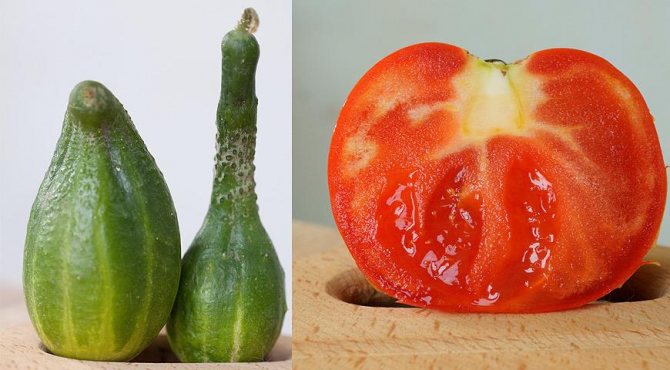

Lack of potassium in cucumbers and tomatoes
Grapes
Grapes picky about potassium. If grapes don't get enough potassium, they can pull potassium from older leaves, redirecting it to younger shoots. Fruiting bushes of grapes are annually taken for the growth and formation of fruits up to 10-12 g of potassium.
Substance consumption
The application rates of Kalimagnesia differ from the type of soil and type of soil. Increased proportions when fertilizing are necessary for plants that are sensitive to chlorine. There are also features of use: the dosage of fertilizer should not exceed 35 g per 10 sq. m. of land.
The use of fertilizer is most productive and effective if all feeding activities are carried out in the fall. The second fertilization will have to occur during the growing season.
Some experienced agronomists prepare the solution without weighing. In other words, "by eye". It is forbidden to do this, since the correct dosage is important for cucumbers, as well as for tomatoes. Extra grams harm the taste.
Interesting fact! If there are no scales at hand, and there is a difficulty in diluting Kalimagnesia, then you can use the following folk tips: matchbox - 20 g, 15 g = 1 tbsp. l., 5 g = 1 tsp.
Instructions for use are written in accessible language. Nevertheless, it is worth clarifying some points:
- in the autumn period - 10 sq. m = 200 g of the mixture;
- spring feeding - the dosage is halved;
- greenhouse - 50 g of dry mix or 20 g per 10 liters of water.
The best potash fertilizers for your garden
| |
| Lebozol POTASSIUM 450 suitable for feeding plants in the second half of the growing season: it compensates for the lack of potassium, which is necessary for fruit formation, increases productivity, the content of sugars and vitamins in fruits and roots, and also increases the winter hardiness of plants. Contains specialized components that allow it to be better distributed over the leaf surface during foliar feeding, increase the absorption of the fertilizer and make it resistant to being washed off by rain. | Brand Bona forte developed a complex granular fertilizer “Universal. Fall" according to the technology "all batteries in one granule". The high content of phosphorus and potassium improves metabolism and stimulates the growth of the root system, nitrogen ensures complete solubility of the fertilizer and better absorption of phosphorus and potassium. The granules dissolve well, so the nutrients are evenly distributed in the soil: 5 kg of fertilizer is enough for 8 acres! |
| |
| Complex granular fertilizer with prolonged action FERTIKA Lawn. Fall" contains all the necessary macro- and microelements in an optimal ratio. The increased content of phosphorus and potassium ensures good rooting of the mixtures and contributes to the formation of a powerful root system. Fertilizer provides good overwintering of plants and, in general, high safety of the lawn. | HUMATE POTASSIUM "SUFFLER" - highly concentrated organic mineral fertilizer with a high content of humic acids. It increases the resistance of plants to fungal and bacterial diseases, accelerates the growth of green mass and ripening of fruits, and also helps plants to endure the cold period more easily. |
How potassium magnesium affects the soil
Kalimagnesia is suitable for fertilizing almost all types of soil. Top dressing will eliminate the deficiency of potassium and magnesium in acidic and podzolic soil. In peat, bog and floodplain soils, as well as in red earth, magnesium is present, but there is a lack of potassium and sulfur. Fertilizing will help to normalize the composition of these soil types.
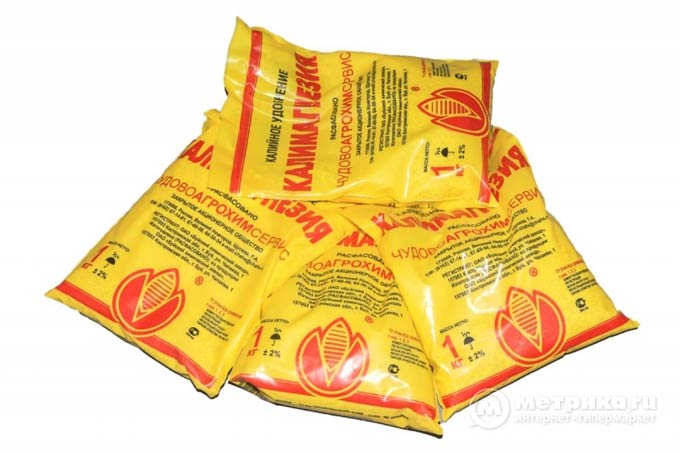

In loamy and forest soils, as well as leached chernozem, fertilization is effective only when properly moistened. Chernozems do not require such fertilizers, since they contain a lot of potassium. Top dressing can be used to compensate for the deficiency of magnesium and sulfur in such soil, but it is more advisable to use magnesium sulfate.
A warning!
Kalimag is made from mineral raw materials. It contains a small amount of natural potassium chloride (see below). By the standards of chlorophobic plants (not chlorine-loving, also see below) insignificant, but! Natural chloride is naturally radioactive. Not the same as granite and basalt massifs (near which many people live for a long time and well), but still more than on lands - standards of eco-purity. Therefore, firstly, if you live in a more or less clean region, then with regular use of kalimagnesia, the harvest radiophone will approach from below the sanitary standards in 200-300 years. But if your site is in the foothills of young mountains or underground you have volcanic or intrusive rocks, it is better to give potassium and sulfur to plants with potassium sulfate, and magnesium separately - who knows, maybe you are already within the radionuclide norms and a little to the top.
Secondly, the place of origin of raw materials matters. The radioactivity of potassium magnesium is determined by isotopes 35Cl, 36Cl and 37Cl. The 35th and 37th are natural, stable and the radiophone gives insignificant - on Valdai there is more natural. But the technogenic 36th with a half-life of 301 thousand years "shines" already perceptibly, 0.21 μSv / h - 0.55 μSv / h, depending on the place of origin of the raw material. What values can the radiophone of kalimagnesia reach, see the video:
Video: about the radioactivity of potassium magnesium
Corollary 1: kalimag from manufacturers located closer to approx. 200 km to the Chernobyl zone - do not take it for sure!
Corollary 2: Kalimag cannot be purchased from places closer than 50-100 km to nuclear enterprises without checking with a radiometer. Uralkhimovskaya, by the way, is not on sale and is not visible - it seems that they know what they are dealing with.
Corollary 3: 36Cl can be targeted locally. Therefore, if you live closer than the same 50-100 km to some nuclear facility, it is better to refuse fertilizers with chlorine altogether. And if such a monster as PUGR (Industrial Uranium-Graphite Nuclear Reactor; there are no longer operating ones, and thank God) puffed within the same limits - unconditionally refuse. The nuclear scientists immediately dubbed the PUGR the Serpent Gorynych, and after the Chernobyl disaster they renamed it mini-Chernobyl.
Corollary 4: kalimagnesia can be applied without fear from regions where geologically old continental shields are covered with a thick layer of sedimentary rocks. In the Russian Federation, this is Central Russia.



